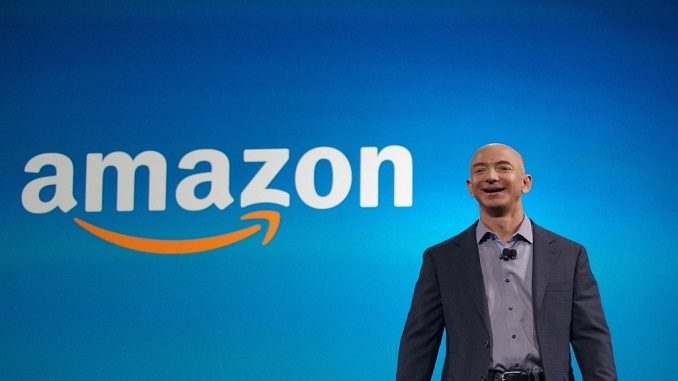
Amazon shares rose as much as 1.9 percent, pushing the company briefly beyond a market value of $1 trillion, a milestone that was already reached by Apple last month, Bloomberg reports.
Founded in 1994 in a Seattle garage as a small online book seller, it’s a historic achievement for CEO Jeff Bezos, who in the process also became the world’s wealthiest person, running a diversified global enterprise with more than $200 billion in annual sales and more than 575,000 employees.
While Amazon has come a long way from its humble beginnings, things moved fast particularly in the past few years. The shares have more than tripled since 2015, reaching a high of $2,050.50 on Tuesday. After crossing the $1 trillion mark, Amazon’s valuation slipped to $988.8 billion at 12:27 p.m. in New York. According to Bloomberg, tech competitors Alphabet and Microsoft are closing in on the mark, too.
CNBC notes that it took Apple 38 years to reach the $1 trillion market value, while Amazon did it in just 21. Both companies got there by consistently improving their core products, but Amazon has also diversified its portfolio very quickly, dominating in areas ranging from online retail to cloud.
Investors are also way more excited about Amazon than other grocery, building supply, and general retail stocks, which have an average price-to-earnings ratio of between about 20 and 40 for the previous year, according to New York University finance professor and valuation expert Aswath Damodaran. Amazon’s price-to-earnings ratio is about 180, CNN adds.
However, Apple and Amazon aren’t the first trillion-dollar corporations. Energy company PetroChina Co. briefly crossed that valuation in late 2007 but slumped quickly as oil prices collapsed in the financial crisis. Still, the online retailer is among the most feared and menacing competitors across a broad swathe of industries.
The biggest contributor to Amazon’s success is the Prime membership, launched in 2005. Bezos borrowed a page from discount warehouse shopping clubs and offered cheaper shipping rates to customers paying an annual membership fee that is now $119 in the U.S. Membership converts the occasional online shopper into an Amazon devotee eager to get their money’s worth on shipping. And Amazon keeps adding more perks, like video streaming, online photo storage and most recently discounts at Whole Foods Market, which Amazon acquired last year for $13.7 billion to jump-start its grocery business.
Amazon now has more than 100 million Prime members, which it uses to lure more inventory to its web store, where competition among merchants keeps prices low. Its annual Prime Day sale, sometimes called Christmas in July, generates tremendous publicity and helps attract new members seeking discounts, Bloomberg noted.




Be the first to comment